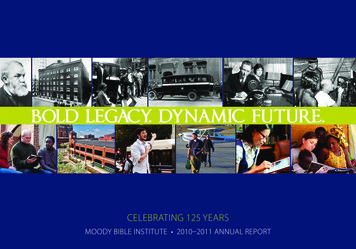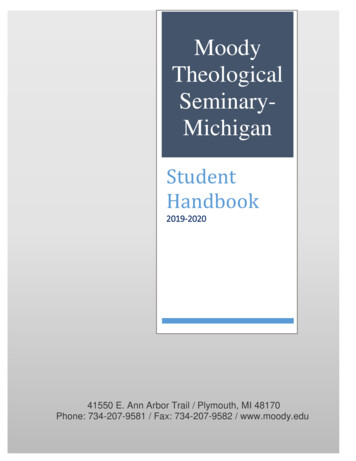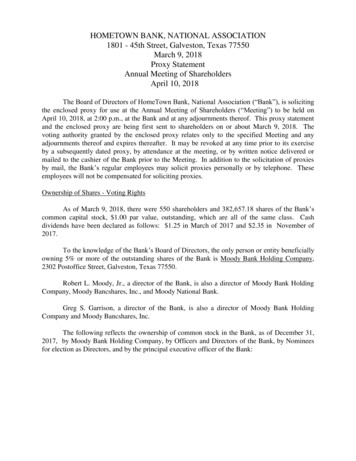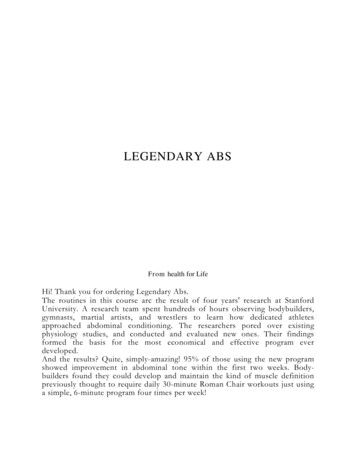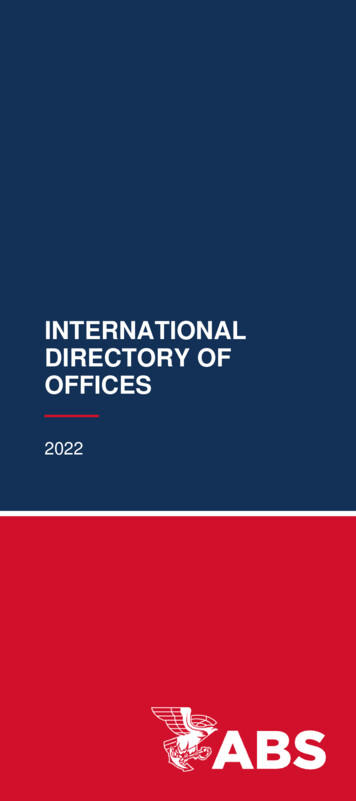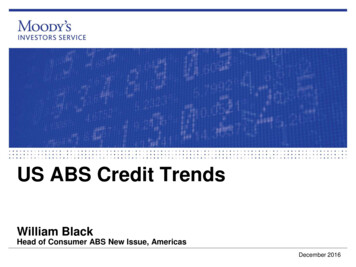
Transcription
US ABS Credit TrendsWilliam BlackHead of Consumer ABS New Issue, AmericasDecember 2016
Contents1. Macroeconomic Backdrop2. US Auto ABS3. US Credit Card ABS4. US Equipment ABS5. Emerging ABS Sectors»Marketplace Lending (MPL)»Handset Financing»Property Assessed Clean Energy (PACE)»SolarUS ABS Credit Trends – December 20162
1Macroeconomic BackdropUS ABS Credit Trends – December 20163
Strengthening Labor MarketUnemployment Expected to Continue at Current Levels as Consumer Sentiment Remains StableUnemployment rate: Total, (%, SA)Baseline Scenario (November 2016)12011%100Consumer Sentiment: Q1-66 10010%8%7%6%5%806040204%Source: U.S. Bureau of Labor Statistics, Moody’s n-17Jul-17Jan-18Jul-18Unemployement Rate9%Source: University of MichiganUS ABS Credit Trends – December 20164
Household Debt Service Ratio, (% of Disposable Inc., SA)West TX Intermediate Spot: Cushing, (FOB per Barrel, NSA)Baseline Forecast (November 2016)Baseline Scenario (November 2016)12.0%12011.5%100Source: Federal Reserve, Moody’s llars per 7Sep-17Mar-18Sep-18Percentage of Disposable IncomeHousehold Debt and Oil Expected to RiseSource: U.S. Energy Information Administration, Moody’s AnalyticsUS ABS Credit Trends – December 20165
Issuance Tote BoardCumulative Issuance, 2015-2016Cumulative Issuance by Asset Class, 2016Transactions closed through 31 October 2016Percentage, transactions announced through 8 November 201620152016200As Percentage of Dollar Amount180Credit Cards13%160Dollars s8%40ConsumerLoans6%Equipment6%20Source: Moody’s Investors uneMayAprilMarchFebruaryJanuary0Source: Moody’s Investors ServiceUS ABS Credit Trends – December 20166
Spreads on 5-Year Fixed Credit Card ABSSpreads Spike During Crisis But Remains Stable Since 2010 Between 20 and 60 Basis PointsFive Year Fixed Card Spreads (basis 07Jan-070Source: Asset Backed Alert, Deutsche BankUS ABS Credit Trends – December 20167
2US Auto ABSUS ABS Credit Trends – December 20168
Auto Sales and Outstanding Auto LoansSales of New Autos and Light Trucks Will Likely Slow, but Pace Will Remain Strong20,000 1,20018,000 1,00016,000 80014,000 60012,000 40010,000 200Outsanding Auto Loanss (Billions)New Vehicle Sales (Units, Thousands)New Vehicle Sales: Autos and light trucks, (Ths. Units, SAAR)Baseline Scenario (November 2016)Consumer Credit: Motor vehicle loans: Owned and securitized, (Bil. USD, NSA) rce: US Bureau of Economics, Federal Reserve, Moody’s AnalyticsUS ABS Credit Trends – December 20169
Key Credit Themes» Credit quality of new auto loan ABS will remain largely consistent with 2016 pools» Stable economic environment and build-up of credit enhancement will keep creditperformance of outstanding auto loan ABS transactions strong in 2017» Stable used car values will help support auto lease ABS performance, owing tocontinued demand for used vehicles» Floorplan ABS performance will continue to benefit from robust auto sales andongoing consolidation of dealer networks» Idiosyncratic issues owing to recalls, other events will continue to affect some autoABSUS ABS Credit Trends – December 201610
Credit Quality of New Auto Loan ABS Will Stabilize» Credit quality of new auto loans will remain consistent with 2016 transactions, which willhelp performance of new auto loan ABS transactions» Stability of new auto loan origination is a result of slight tightening of underwritingSummary of Collateral and Loan Terms at Securitization Closing by Year of IssuancePrime poolsWA OT (months)WA RT200661.82007Sub-prime poolsWA FICO53.3WA APR(%)6.6WA OT (months)WA RT721WA New(%)75.5WA FICO60.3WA APR(%)17.5577WA 4.473864.870.467.917.457033.22016 Through Q364.354.23.774374.168.463.916.358034.9YearSource: Moody’s Investors ServiceUS ABS Credit Trends – December 201611
Credit Performance of Outstanding Prime Loan PoolsWill Remain Strong» Annualized net loss rates will continue to increase year-over-year but lifetimecumulative net losses will remain within expectations–Prime transactions have incurred higher losses since 2011 due to weakening credit qualityCumulative Net Losses in Prime Auto Loan ABS Pools Have Increased from 2010-11 Cumulative Net Loss2.5%2.0%1.5%1.0%0.5%0.0%14710131619Months Since Closing2225283134Source: Moody's Investors Service, servicing reportsUS ABS Credit Trends – December 201612
Auto Lease ABS Performance Will Remain Strong» The credit performance of auto lease ABS transactions will remain robust in 2017,supported by the steady economic environment; residual value performance will remainsteady due to a stable used vehicle market» Leasing will continue to gain popularity, as reflected by its rising penetration rate– As of Q3 2016, leasing as a percentage of new vehicle sales is at 29%, from 18% in Q3 2010– Credit quality of lessees has been steady both in the general market and in the securitized leasepools, as reflected by consistent credit scores in 2016 compared with 2015» However, lower vehicle trade-in values, along with a looming interest rate increase,could reduce lease affordabilityUS ABS Credit Trends – December 201613
Floorplan ABS Performance Will Continue to Benefitfrom Robust Auto Sales and Consolidation of Dealers» Stable auto sales will continue to be credit positive for dealer floorplan ABS in 2017 bymaintaining the ABS payment rates well above trigger levels.–Auto dealers continue to benefit from high new vehicle sales, as seasonally adjusted annual salesonce again averaged around 17.5 million units in Q3 2016. Demand remains high, enablingdealers to grow further. Consolidation of small dealers will continue as a result of larger dealersputting capital to work through acquisitions.–Larger dealers tend to be less vulnerable to downturns in vehicle sales, because they have othersources of revenue such as selling vehicle parts or providing automotive maintenance» Despite a slowdown in the growth rate of auto sales, as anticipated by Moody’sAnalytics, dealers will be supported by high gross margin parts and service operationsUS ABS Credit Trends – December 201614
Regulators Will Continue to Scrutinize BusinessPractices of Auto Lenders» Regulatory scrutiny of subprime auto lenders is likely to continue» Although the scrutiny could strengthen the industry over the long term if it helps toweed out unethical lending practices, credit performance could decline over the shortterm if regulators require changes to loan servicing and collection practices» As of November 2016 Auto ABS issuers will need to comply with additionalrequirements under Reg AB II, a US Securities and Exchange Commission disclosurerule–Reg AB II mandates loan-level disclosure about securitized pools–The added disclosures will enhance transparency and reporting requirements of auto ABS» For securitizations that close after December 2016, ABS issuers in the public marketwill need to add information in their prospectuses regarding their risk retention, arequirement under the Dodd-Frank Act–The disclosures will include the form of risk retention (horizontal, vertical or a combination ofthe two) and the method of calculating the fair value of the notes and residual interestUS ABS Credit Trends – December 201615
3US Credit Card ABSUS ABS Credit Trends – December 201616
Key Credit Themes» US credit card ABS will continue to perform well through 2017‒Strong economy and seasoned card accounts with high quality collateral drive strong performance» While managed portfolio performance diverges from trust performance, the Big Sixsponsors will maintain their credit strength» Risks will be low for credit card trusts in the near term–Likelihood of significant new account additions is low–Aaa rated notes are highly resilient» Today’s exceptional credit quality and performance will not lastUS ABS Credit Trends – December 201617
US Credit Card ABS Will Continue to Perform WellThrough 2017 as Charge-Offs Will Remain Low» Charge-off rates and total delinquencies continue to remain low, owing to the veryseasoned, high credit quality credit card accounts backing the ABS– A large portion of receivables generated by weaker borrowers exited the card trusts whensponsors charged off their accounts after the recession– Most issuers have not added new receivables in recent years, so trust portfolios contain fewerrisky borrowers and more transactorsCharge-offs and Total Delinquencies Are Low80%YOY ChangeCharge-off Rate50%127YoY ChangeTotal Delinquency Rate40%60%1040%20%8-20%40%4-10%3-20%-30%Percentage (%)6YOY Change (%)0%510%Percentage (%)20%YOY Change ul-15Jan-16Jul-162-60%Source: Moody’s Investors Service based on data from public trust filingsUS ABS Credit Trends – December 201618
US Credit Card ABS Will Continue to Perform WellThrough 2017 as Excess Spread Remains High» The strong economic environment in the US and the high proportion of transactors inthe securitized pools will support this elevated level of payments» Excess spread is at elevated levels because of lower charge-offs, lower coupons onthe bonds, elevated finance charges compared to the prevailing low interest rates,and increased interchangePrincipal Payment Rates and Excess Spread Remain ElevatedYOY ChangePayment Rate (3-Mo Avg)28120%YoY Change3-Month Avg 0%1716-15%YOY Change (%)5%1060%Percentage (%)YOY Change e (%)25%Source: Moody’s Investors Service based on data from public trust filingsUS ABS Credit Trends – December 201619
Today’s Exceptional Credit Quality and PerformanceWill Not Last» Performance of credit card receivables will face risks beyond 2016 as consumer debtand interest rates continues to increase and banks continue to loosen their underwritingstandardsStandards Loosen for Credit Cards as the Economy Recovers from the RecessionNet Percentage of Domestic Banks Relaxing (Tightening) Standards on Credit -70%-80%Note: Data are net percentages of total respondents to the April 2016 Federal Reserve Board Senior Loan Officer Opinion Survey. Percentages above zero indicate relaxingunderwriting standards and stronger demand for credit cards. Percentages below zero indicate tightening underwriting standards and weaker demand for credit cards. Data reflectsdemand for credit cards since Q2 2011 and for all consumer loans before that date.Source: Federal Reserve, Moody's Investors ServiceUS ABS Credit Trends – December 201620
4US Equipment ABSUS ABS Credit Trends – December 201621
Key Credit Themes» Despite slight declines in economic growth, credit quality of Equipment ABS remainstrong in 2016, owing to the financial stability of the underlying obligors– New agriculture and construction equipment ABS continue to exhibit slight weaknessas a result of weakness in the agricultural market.– Uncertain economic environment may affect performance of new and outstandingABS backed by trucking transportation and other equipment loans, such as medical,mining and drilling equipment.– The good credit quality of new and outstanding small-ticket equipment ABStransactions continue to be reflected by the low loss rates on the loans to generallyhigh-quality obligors underlying the equipment contracts in these transactionsUS ABS Credit Trends – December 201622
5Emerging SectorsUS ABS Credit Trends – December 201623
5.1Marketplace LendingUS ABS Credit Trends – December 201624
Key Credit Themes» Marketplace Lending (MPL) originations are hampered by increased regulatoryscrutiny» MPL ABS issuance picks up despite market challenges» Any weakness in the US economy will further stress on the nascent MPL industry» Legal and regulatory risks continue to be at the forefront‒Viability of the partner-bank loan origination model remains uncertain‒Marketplace lenders have altered their strategies and business models to mitigate risk‒Increased regulatory oversight from governing bodies may burden MPL platforms» Recent events shed light to risks related to corporate governance and data quality» Performance of outstanding ABS in 2017 will be stableUS ABS Credit Trends – December 201625
MPL Originations Hampered by Increased Scrutiny» Regulators are looking closely at marketplace lenders as a result of negativedevelopments in 2016 including:‒Lending Club’s CEO resigning amid questions about data manipulation and conflicts of interest‒The weaker than expected performance of some marketplace lending platforms‒Recent court developments that highlighted legal risks associated with the partner-bankorigination modelRapid Growth of Marketplace Loan Originations Ended in 201617.5% 3.517.0% 3.016.5% 2.516.0% 2.015.5% -14 0.0Q2-1414.5%Q1-14 0.5Q4-1315.0%Q3-13 1.0Q2-13Originations (billions)Weighted Average Interest RateWA Interest RateUnsecured Consumer Loan Originations 4.0Source: Orchard Platform, Moody’s Investors ServiceUS ABS Credit Trends – December 201626
5.2Handset FinancingUS ABS Credit Trends – December 201627
Handset Financing Continues to Increase» Seller financing – i.e. installment plans/loans and leases – is now part of mostconsumers’ purchases of mobile phones, reflecting a shift since 2013 away from offersof subsidies for device purchases at all of the Big Four carriers:– Verizon Communications, Inc.– AT&T Corporation– T-Mobile US Inc.– Sprint Corporation» The wide adoption signals the diverse credit quality of borrowers taking on the contractsSprint Sales Illustrate How Consumers Are Moving Toward Phone FinancingSubsidy/otherInstallment plansLeasingTotal 14Sep-1480%70%60%50%40%30%20%10%0%Quarter EndingSource: Company presentations, Moody’s Investors ServiceUS ABS Credit Trends – December 201628
5.3Property Assessed Clean Energy(PACE)US ABS Credit Trends – December 201629
PACE Provides Financing of Home Improvements» PACE programs provide financing of energy efficiency, renewable energy and waterconservation upgrades to residential and commercial properties–Local governments partner with private lenders to provide 100% financing to homeowners foreligible clean energy home improvement projects; homeowners repay the costs through longterm special tax assessments that local governments place on property tax bills–PACE programs are enacted through state legislation, currently established in 33 states and DC–PACE legislation typically specifies that a PACE lien is senior to all pre-existing non-tax liens,including first-lien mortgagesComparison of PACE with Other Asset ClassesTax Liens*Senior PACESubordinate ntaryObligation Assumed by SubsequentProperty OwnerNoYesYesNoFuture Payments Accelerated lly SubordinatedN/AUse of ProceedsN/AProperty ImprovementsProperty ImprovementsAnyTypical LTV LimitN/A15%15%60-97%****Lien TypeSeniority to Mortgage* Liens on properties arising out of delinquent property taxes, assessments, sewer rents, sewer surcharges, water rents, and/or other charges**The decision to join a PACE assessment district is voluntary, but the incurrence of a PACE lien is considered involuntary under some PACE legislation*** Stipulated by PACE legislation in most states such as California**** For agency mortgagesSource: Moody's Investors ServiceUS ABS Credit Trends – December 201630
5.4SolarUS ABS Credit Trends – December 201631
Solar Loans Are Becoming a Larger Share of NewOriginations» Solar loan originations are likely to increase in 2017, resulting in solar loan ABS‒Over half of the systems will be owned rather than leased in 2017 based on GTM Research» As costs of residential solar photovoltaic (PV) systems decline, more financing options,such as loans, become available‒Some loans might offer more savings than leases and power purchase agreements (PPAs)Customer Owned Systems Will Exceed Third Party Owned for New Residential Solar in 2017Source: GTM ResearchUS ABS Credit Trends – December 201632
This publication does not announce a credit rating action. For any credit ratings referenced in this publication, please see the ratings tab on the issuer/entity page on www.moodys.com for the mostupdated credit rating action information and rating history. 2016 Moody’s Corporation, Moody’s Investors Service, Inc., Moody’s Analytics, Inc. and/or their licensorsand affiliates (collectively, “MOODY’S”). All rights reserved.CREDIT RATINGS ISSUED BY MOODY'S INVESTORS SERVICE, INC. AND ITS RATINGS AFFILIATES(“MIS”) ARE MOODY’S CURRENT OPINIONS OF THE RELATIVE FUTURE CREDIT RISK OF ENTITIES,CREDIT COMMITMENTS, OR DEBT OR DEBT-LIKE SECURITIES, AND CREDIT RATINGS ANDRESEARCH PUBLICATIONS PUBLISHED BY MOODY’S (“MOODY’S PUBLICATIONS”) MAY INCLUDEMOODY’S CURRENT OPINIONS OF THE RELATIVE FUTURE CREDIT RISK OF ENTITIES, CREDITCOMMITMENTS, OR DEBT OR DEBT-LIKE SECURITIES. MOODY’S DEFINES CREDIT RISK AS THERISK THAT AN ENTITY MAY NOT MEET ITS CONTRACTUAL, FINANCIAL OBLIGATIONS AS THEYCOME DUE AND ANY ESTIMATED FINANCIAL LOSS IN THE EVENT OF DEFAULT. CREDIT RATINGSDO NOT ADDRESS ANY OTHER RISK, INCLUDING BUT NOT LIMITED TO: LIQUIDITY RISK, MARKETVALUE RISK, OR PRICE VOLATILITY. CREDIT RATINGS AND MOODY’S OPINIONS INCLUDED INMOODY’S PUBLICATIONS ARE NOT STATEMENTS OF CURRENT OR HISTORICAL FACT. MOODY’SPUBLICATIONS MAY ALSO INCLUDE QUANTITATIVE MODEL-BASED ESTIMATES OF CREDIT RISKAND RELATED OPINIONS OR COMMENTARY PUBLISHED BY MOODY’S ANALYTICS, INC. CREDITRATINGS AND MOODY’S PUBLICATIONS DO NOT CONSTITUTE OR PROVIDE INVESTMENT ORFINANCIAL ADVICE, AND CREDIT RATINGS AND MOODY’S PUBLICATIONS ARE NOT AND DO NOTPROVIDE RECOMMENDATIONS TO PURCHASE, SELL, OR HOLD PARTICULAR SECURITIES.NEITHER CREDIT RATINGS NOR MOODY’S PUBLICATIONS COMMENT ON THE SUITABILITY OF ANINVESTMENT FOR ANY PARTICULAR INVESTOR. MOODY’S ISSUES ITS CREDIT RATINGS ANDPUBLISHES MOODY’S PUBLICATIONS WITH THE EXPECTATION AND UNDERSTANDING THAT EACHINVESTOR WILL, WITH DUE CARE, MAKE ITS OWN STUDY AND EVALUATION OF EACH SECURITYTHAT IS UNDER CONSIDERATION FOR PURCHASE, HOLDING, OR SALE.MOODY’S CREDIT RATINGS AND MOODY’S PUBLICATIONS ARE NOT INTENDED FOR USEBY RETAIL INVESTORS AND IT WOULD BE RECKLESS AND INAPPROPRIATE FOR RETAILINVESTORS TO USE MOODY’S CREDIT RATINGS OR MOODY’S PUBLICATIONS WHEN MAKING ANINVESTMENT DECISION. IF IN DOUBT YOU SHOULD CONTACT YOUR FINANCIAL OR OTHERPROFESSIONAL ADVISER.ALL INFORMATION CONTAINED HEREIN IS PROTECTED BY LAW, INCLUDING BUT NOT LIMITED TO,COPYRIGHT LAW, AND NONE OF SUCH INFORMATION MAY BE COPIED OR OTHERWISEREPRODUCED, REPACKAGED, FURTHER TRANSMITTED, TRANSFERRED, DISSEMINATED,REDISTRIBUTED OR RESOLD, OR STORED FOR SUBSEQUENT USE FOR ANY SUCH PURPOSE, INWHOLE OR IN PART, IN ANY FORM OR MANNER OR BY ANY MEANS WHATSOEVER, BY ANYPERSON WITHOUT MOODY’S PRIOR WRITTEN CONSENT.All information contained herein is obtained by MOODY’S from sources believed by it to be accurate andreliable. Because of the possibility of human or mechanical error as well as other factors, however, allinformation contained herein is provided “AS IS” without warranty of any kind. MOODY'S adopts all necessarymeasures so that the information it uses in assigning a credit rating is of sufficient quality and from sourcesMOODY'S considers to be reliable including, when appropriate, independent third-party sources. However,MOODY’S is not an auditor and cannot in every instance independently verify or validate information receivedin the rating process or in preparing the Moody’s Publications.To the extent permitted by law, MOODY’S and its directors, officers, employees, agents, representatives,licensors and suppliers disclaim liability to any person or entity for any indirect, special, consequential, orincidental losses or damages whatsoever arising from or in connection with the information contained hereinor the use of or inability to use any such information, even if MOODY’S or any of its directors, officers,employees, agents, representatives, licensors or suppliers is advised in advance of the possibility of suchlosses or damages, including but not limited to: (a) any loss of present or prospective profits or (b) any loss ordamage arising where the relevant financial instrument is not the subject of a particular credit rating assignedby MOODY’S.To the extent permitted by law, MOODY’S and its directors, officers, employees, agents, representatives,licensors and suppliers disclaim liability for any direct or compensatory losses or damages caused to anyperson or entity, including but not limited to by any negligence (but excluding fraud, willful misconduct or anyother type of liability that, for the avoidance of doubt, by law cannot be excluded) on the part of, or anycontingency within or beyond the control of, MOODY’S or any of its directors, officers, employees, agents,representatives, licensors or suppliers, arising from or in connection with the information contained herein orthe use of or inability to use any such information.NO WARRANTY, EXPRESS OR IMPLIED, AS TO THE ACCURACY, TIMELINESS, COMPLETENESS,MERCHANTABILITY OR FITNESS FOR ANY PARTICULAR PURPOSE OF ANY SUCH RATING OROTHER OPINION OR INFORMATION IS GIVEN OR MADE BY MOODY’S IN ANY FORM OR MANNERWHATSOEVER.Moody’s Investors Service, Inc., a wholly-owned credit rating agency subsidiary of Moody’s Corporation(“MCO”), hereby discloses that most issuers of debt securities (including corporate and municipal bonds,debentures, notes and commercial paper) and preferred stock rated by Moody’s Investors Service, Inc. have,prior to assignment of any rating, agreed to pay to Moody’s Investors Service, Inc. for appraisal and ratingservices rendered by it fees ranging from 1,500 to approximately 2,500,000. MCO and MIS also maintainpolicies and procedures to address the independence of MIS’s ratings and rating processes. Informationregarding certain affiliations that may exist between directors of MCO and rated entities, and between entitieswho hold ratings from MIS and have also publicly reported to the SEC an ownership interest in MCO of morethan 5%, is posted annually at www.moodys.com under the heading “Investor Relations — CorporateGovernance — Director and Shareholder Affiliation Policy.”Additional terms for Australia only: Any publication into Australia of this document is pursuant to the AustralianFinancial Services License of MOODY’S affiliate, Moody’s Investors Service Pty Limited ABN 61 003 399657AFSL 336969 and/or Moody’s Analytics Australia Pty Ltd ABN 94 105 136 972 AFSL 383569 (asapplicable). This document is intended to be provided only to “wholesale clients” within the meaning of section761G of the Corporations Act 2001. By continuing to access this document from within Australia, yourepresent to MOODY’S that you are, or are accessing the document as a representative of, a “wholesaleclient” and that neither you nor the entity you represent will directly or indirectly disseminate this document orits contents to “retail clients” within the meaning of section 761G of the Corporations Act 2001.MOODY’S credit rating is an opinion as to the creditworthiness of a debt obligation of the issuer, not on theequity securities of the issuer or any form of security that is available to retail investors. It would be recklessand inappropriate for retail investors to use MOODY’S credit ratings or publications when making aninvestment decision. If in doubt you should contact your financial or other professional adviser.Additional terms for Japan only: Moody's Japan K.K. (“MJKK”) is a wholly-owned credit rating agencysubsidiary of Moody's Group Japan G.K., which is wholly-owned by Moody’s Overseas Holdings Inc., awholly-owned subsidiary of MCO. Moody’s SF Japan K.K. (“MSFJ”) is a wholly-owned credit rating agencysubsidiary of MJKK. MSFJ is not a Nationally Recognized Statistical Rating Organization (“NRSRO”).Therefore, credit ratings assigned by MSFJ are Non-NRSRO Credit Ratings. Non-NRSRO Credit Ratingsare assigned by an entity that is not a NRSRO and, consequently, the rated obligation will not qualify forcertain types of treatment under U.S. laws. MJKK and MSFJ are credit rating agencies registered with theJapan Financial Services Agency and their registration numbers are FSA Commissioner (Ratings) No. 2and 3 respectively.MJKK or MSFJ (as applicable) hereby disclose that most issuers of debt securities (including corporate andmunicipal bonds, debentures, notes and commercial paper) and preferred stock rated by MJKK or MSFJ (asapplicable) have, prior to assignment of any rating, agreed to pay to MJKK or MSFJ (as applicable) forappraisal and rating services rendered by it fees ranging from JPY200,000 to approximately JPY350,000,000.MJKK and MSFJ also maintain policies and procedures to address Japanese regulatory requirements.US ABS Credit Trends – December 201634
US ABS Credit Trends - December 2016 11 » Credit quality of new auto loans will remain consistent with 2016 transactions, which will help performance of new auto loan ABS transactions » Stability of new auto loan origination is a result of slight tightening of underwriting Credit Quality of New Auto Loan ABS Will Stabilize
